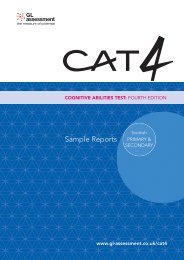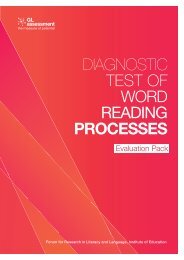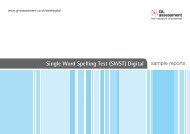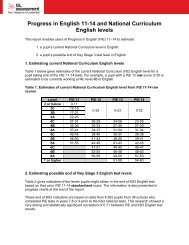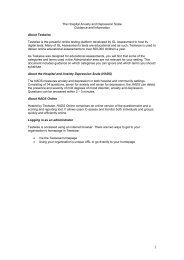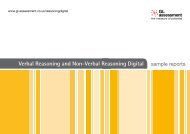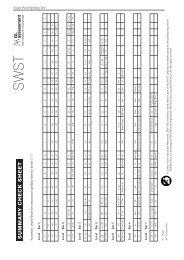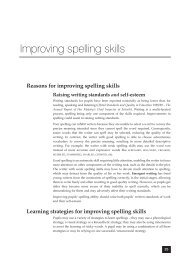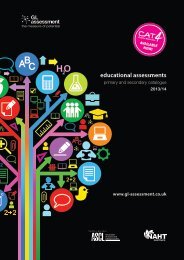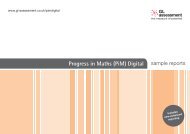BAS3 Parent Report Early Years - GL Assessment
BAS3 Parent Report Early Years - GL Assessment
BAS3 Parent Report Early Years - GL Assessment
- No tags were found...
You also want an ePaper? Increase the reach of your titles
YUMPU automatically turns print PDFs into web optimized ePapers that Google loves.
<strong>BAS3</strong> PARENT REPORT<br />
What is the <strong>BAS3</strong>?<br />
The British Ability Scales 3 (<strong>BAS3</strong>) is a collection of individual tests that are used to assess the general thinking and reasoning skills of children aged from 3 to 17<br />
years. The tests are designed to measure abilities that are important for learning, such as problem solving, remembering things, working out how things relate to<br />
one another and understanding language.<br />
Why has my child been assessed?<br />
Gagan is a Year 1 child who has had a Statement of Special Educational needs since 2009. Gagan has a brittle bone condition. It was concluded during statutory<br />
assessment that as well as physical difficulties linked to her bone condition she has very low cognitive ability, difficulties with social skills, delayed language and<br />
difficulties with self help skills. Gagan has attended Hightop School, a maintained special school that specialises in providing for young people with physical<br />
difficulties and learning difficulties, since the start of Reception. Gagan's parents speak English and Punjabi at home; they consider English to be Gagan's first<br />
language. Educational Psychology input was requested by Hightop School to provide up‐to‐date evidence about Gagan's special educational needs as school felt<br />
that Gagan has made considerable progress with learning during her time at Hightop. No cognitive assessment was done during Gagan's statutory assessment;<br />
school wonder whether the conclusions that were drawn about her cognitive ability during statutory assessment were an underestimate. If this were the case,<br />
school wondered whether it was appropriate for Gagan to start accessing mainstream school. On 4 November, 2011, I spoke with Gagan's class teacher and<br />
nursery nurse and I observed Gagan in class. On 7 November, 2011, I returned and completed the British Ability Scales 3 <strong>Early</strong> <strong>Years</strong> (<strong>BAS3</strong>) with Gagan to assess<br />
her strengths and weaknesses in verbal skills, pictorial reasoning and spatial skills. As I was told that Gagan can be nervous when working with unfamiliar adults,<br />
and as Gagan's sister (Rupi) happened to be present in school that morning, Rupi was present during the assessment.<br />
© 2012 <strong>GL</strong> <strong>Assessment</strong> Limited<br />
Created on 27/03/2012 for A. Psychologist of Independent <strong>Assessment</strong> Services 1
<strong>BAS3</strong> PARENT REPORT<br />
What do the <strong>BAS3</strong> results show?<br />
Your child completed the tests that were most suited to identifying her<br />
needs. The tests in the <strong>BAS3</strong> combine to produce different types of scores.<br />
A summary of these scores and the abilities they test is shown below.<br />
Type of<br />
score<br />
Verbal Ability<br />
Non‐verbal<br />
Reasoning Ability<br />
Spatial Ability<br />
General<br />
Conceptual Ability<br />
Special Non‐verbal<br />
Composite<br />
Measures your child’s ability to...<br />
Understand and use spoken words and language.<br />
Work out why numbers, pictures or patterns are<br />
linked with others.<br />
Remember and make sense of shapes and the way<br />
they are arranged.<br />
Use all three kinds of ability – verbal, spatial, nonverbal<br />
reasoning.<br />
This score summarises your child’s overall thinking<br />
and problem solving abilities.<br />
Use two kinds of ability – spatial and non‐verbal<br />
reasoning.<br />
This score is used when children are unable to do<br />
tests involving words, or when they would find such<br />
tests very difficult.<br />
How is the <strong>BAS3</strong> scored?<br />
The <strong>BAS3</strong> scores are presented in percentiles, showing your child’s rank<br />
when compared with what would be expected for 100 children of the same<br />
age. For example, if your child ranked in the 55 th percentile, it would mean<br />
that she scored higher than 55 out of 100 children of the same age.<br />
About two thirds of children will rank between the 16 th and 84 th percentile,<br />
so percentiles help us to decide how typical or unusual your child’s score is.<br />
Descriptions of the percentiles are provided below.<br />
Percentile<br />
Description<br />
1 st – 2 nd Very Low<br />
3 rd – 8 th Low<br />
9 th – 24 th Below Average<br />
25 th – 74 th Average<br />
75 th – 90 th Above Average<br />
91 st – 97 th High<br />
98 th – 99 th Very High<br />
© 2012 <strong>GL</strong> <strong>Assessment</strong> Limited<br />
Created on 27/03/2012 for A. Psychologist of Independent <strong>Assessment</strong> Services 3
<strong>BAS3</strong> PARENT REPORT<br />
Diagnostic tests:<br />
These tests measure your child’s abilities in literacy and numeracy. The results enable her educational progress to be compared against what might be expected<br />
from her scores on the other <strong>BAS3</strong> tests.<br />
Name of test Task your child was asked to complete... Measures your child’s ability to... Percentile Description of<br />
results<br />
<strong>Early</strong> Number<br />
Concepts<br />
Matching Letterlike<br />
Forms<br />
Recall of Digits<br />
Forward<br />
Recall of Digits<br />
Backward<br />
Recall of<br />
Objects:<br />
Immediate<br />
Verbal<br />
Recall of<br />
Objects:<br />
Immediate<br />
Spatial<br />
Shown squares or pictures and asked to answer<br />
questions about numbers, size and other numerical<br />
concepts.<br />
Shown an abstract shape that resembles letters of<br />
the alphabet, with a series of abstract figures below<br />
it (the same shapes rotated or reversed) then asked<br />
to find the identical match to the original shape.<br />
Listen to a series of numbers and repeat them.<br />
Listen to a series of numbers and repeat them<br />
backwards (i.e. in reverse order).<br />
Shown a display card containing a series of drawn<br />
objects and, after the card has been taken away,<br />
asked to name as many of the objects as possible.<br />
After having named the objects in Recall of Objects:<br />
Immediate Verbal, asked to recreate the<br />
arrangement of the original display using a set of<br />
cards with the objects on and a blank grid.<br />
• Use knowledge of basic numbers<br />
• Solve simple number problems<br />
• Understand language about number and other<br />
mathematical ideas<br />
• Recognise and match shapes that have been<br />
reversed or rotated<br />
• Discriminate between similar shapes<br />
• Listen and recall simple number sequences<br />
• Use short‐term memory<br />
• Listen and recall reversed number sequences<br />
• Reverse number sequences<br />
• Name objects<br />
• Remember and recall a series of objects<br />
• Use expressive language (the ability to say things)<br />
• Remember and recall a series of objects<br />
• Remember and recall the arrangement of objects<br />
3 rd Low<br />
4 th Low<br />
10 th Below Average<br />
14 th Below Average<br />
27 th Average<br />
7 th Low<br />
Recall of 15‐20 minutes after completing Recall of Objects: • Name objects 18 th Below Average<br />
© 2012 <strong>GL</strong> <strong>Assessment</strong> Limited<br />
Created on 27/03/2012 for A. Psychologist of Independent <strong>Assessment</strong> Services 7
<strong>BAS3</strong> PARENT REPORT<br />
Summary of the <strong>BAS3</strong> assessment<br />
Views of the child<br />
Gagan said that she likes school and that the best thing about school is that she gets to play with her friend Steff. When asked what could be better about<br />
school, Gagan said, "Nothing."<br />
Views of parents<br />
I spoke to Gagan's mother on the telephone on 7 November, 2011. She spoke about how much progress Gagan has made at Hightop and about how she believes<br />
that this level of progress would not have been made if Gagan had been at a mainstream school. Further, Mrs Grewal commented that she feels that Gagan<br />
would not be able to access mainstream school because of the large number of children there and Gagan's brittle bone condition.<br />
Views of psychologist: Next steps<br />
The results of this assessment suggest that Gagan's cognitive abilities a) are greater than was indicated during her statutory assessment and b) are also greater<br />
than is usual for students on roll at Hightop. Given Gagan's low levels of confidence and her reluctance to engage in conversation it is possible that Gagan's<br />
ability is not fully evident in the classroom environment. Those working with Gagan should be aware of her great strength in pictorial reasoning. Where possible,<br />
visual means of learning (for example, using pictures, computer games and mind‐maps) should be used to supplement and support Gagan's language‐based<br />
learning. Hightop should continue to liaise with Gagan's Occupational Therapist to put in place a programme to develop her fine motor skills and to further<br />
assess her visual‐spatial skills as these are an area of significant weakness. Gagan has made significant progress since her Statement of Special Educational Needs<br />
was written. An interim review has been called at Hightop School (10am on 25 January, 2012) to update her Statement so that it more accurately describes her<br />
needs. All involved in working with Gagan (both her family and professionals) should start to consider the possibility of Gagan accessing some mainstream<br />
inclusion. Gagan remains a vulnerable child both because of her brittle bone condition and her varied learning profile. As such, any mainstream inclusion would<br />
need to be carefully planned and monitored.<br />
Any other comments<br />
Given the level of difference between Gagan's non‐verbal reasoning ability and her general conceptual ability it is best practice to consider her full pattern of<br />
scores rather than to quote her general conceptual ability on its own.<br />
<strong>Assessment</strong> completed by:<br />
A. Psychologist, Independent <strong>Assessment</strong> Services<br />
© 2012 <strong>GL</strong> <strong>Assessment</strong> Limited<br />
Created on 27/03/2012 for A. Psychologist of Independent <strong>Assessment</strong> Services 9




